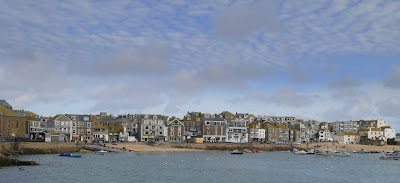Mousehole, along with Marazion, was until the 16th century one of the principal ports of Mount's Bay. Before its decline as a major commercial centre, Mousehole also had a number of fairs and markets, including the charter for a market on Tuesdays, with a fair for three days at the festival of St Barnabas, granted to Henry de Tyes in 1292.
Mousehole, like Penzance, Newlyn, and Paul, was destroyed in the 1595 raid on Mount's Bay by Spaniard Carlos de Amésquita, the only surviving building being the 'Keigwin Arms', a local pub.
Following the travels of a 2011 Brazilian Volkswagen Type 2 camper van around the UK. Zoom in/out on the map to see where we have visited. Click on the marker to find the link direct to that page. I will be adding more and more of my locations from the last few years over the coming weeks.
Saturday, 30 September 2017
Godrevy Head
Godrevy is an area on the eastern side of St Ives Bay which faces the Atlantic Ocean.
Offshore on Godrevy Island is a lighthouse maintained by Trinity House which is said to be the inspiration for Virginia Woolf's novel To the Lighthouse.
The cliffs, offshore rocks and coast around Godrevy Head form a renowned habitat for seabirds including cormorants, fulmars, guillemots, and razorbills and several species of gull. There is also a substantial population of grey seals throughout the year. Occasionally, bottlenose dolphins can be seen in the area.
Offshore on Godrevy Island is a lighthouse maintained by Trinity House which is said to be the inspiration for Virginia Woolf's novel To the Lighthouse.
The cliffs, offshore rocks and coast around Godrevy Head form a renowned habitat for seabirds including cormorants, fulmars, guillemots, and razorbills and several species of gull. There is also a substantial population of grey seals throughout the year. Occasionally, bottlenose dolphins can be seen in the area.
St Ives, Cornwall
From medieval times fishing was important at St Ives and it was the most important fishing port on the north coast.
The modern seaside resort developed as a result of the arrival of the St Ives Bay branch line from St Erth, part of the Great Western Railway in 1877. With it came a new generation of Victorian seaside holidaymakers. Much of the town was built during the latter part of the 19th century. The railway, which winds along the cliffs and bays, survived the Beeching cuts and has become a tourist attraction itself.
Subscribe to:
Posts (Atom)






















































